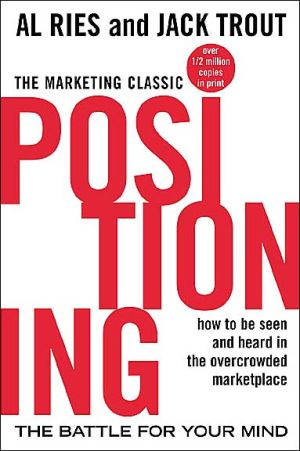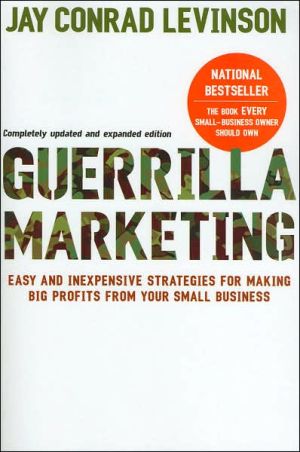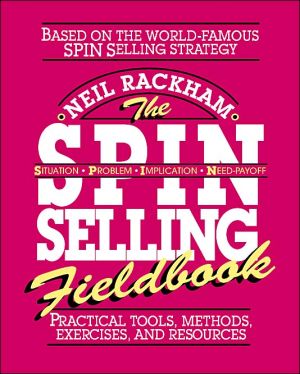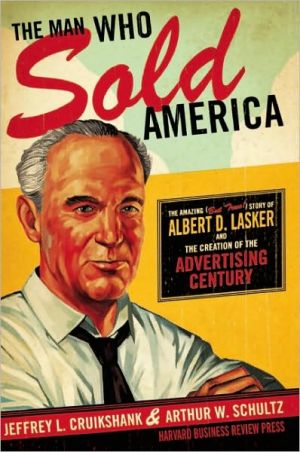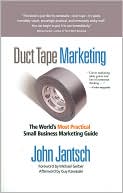Positioning: The Battle for Your Mind
"One of the most important communication books I've ever read. I highly recommend it!"\ Spencer Johnson, author of Who Moved My Cheese? and co-author of The One Minute Manager\ "...Ries and Trout taught me everything I know about branding, marketing, and product management. When I had the idea of creating a very large thematic community on the Web, I first thought of Positioning...."\ David Bohnett, Chairman and Founder of GeoCities\ The first book to deal with the problems of...
Search in google:
This business classic deals with the problems of communicating to a skeptical, media-blitzed public.
Positioning\ The Battle for Your Mind \ \ By Al Ries Jack Trout \ McGraw-Hill\ Copyright © 2001 The McGraw-Hill Companies\ All right reserved.\ ISBN: 978-0-07-137358-6 \ \ \ Chapter One\ What positioning is all about \ How did a hard-sell concept like positioning become so popular in a business noted for its creativity?\ In truth, the past decade might well be characterized as a "return to reality." White knights and black eye patches gave way to such positioning concepts as "Lite Beer from Miller. Everything you always wanted in a beer. And less."\ Poetic? Yes. Artful? Yes. But also a straightforward, clearly defined explanation of the basic positioning premise.\ To be successful today, you must touch base with reality. And the only reality that counts is what's already in the prospect's mind.\ To be creative, to create something that doesn't already exist in the mind, is becoming more and more difficult. If not impossible.\ The basic approach of positioning is not to create something new and different, but to manipulate what's already up there in the mind, to retie the connections that already exist.\ Today's marketplace is no longer responsive to the strategies that worked in the past. There are just too many products, too many companies, and too much marketing noise.\ The question most frequently asked by positioning skeptics is, "Why?" Why do we need a new approach to advertising and marketing?\ The overcommunicated society\ The answer is that we have become an overcommunicated society. The per-capita consumption of advertising in America today is $376.62 a year. (That compares with $16.87 in the rest of the world.)\ If you spend $1 million a year on advertising, you are bombarding the average consumer with less than a half cent of advertising, spread out over 365 days—a consumer already exposed to $376.61&fra12; worth of other advertising.\ In our overcommunicated society, to talk about the "impact" of your advertising is to seriously overstate the potential effectiveness of your message. Advertising is not a sledgehammer. It's more like a light fog, a very light fog that envelops your prospects.\ In the communication jungle out there, the only hope to score big is to be selective, to concentrate on narrow targets, to practice segmentation. In a word, "positioning."\ The mind, as a defense against the volume of today's communications, screens and rejects much of the information offered it. In general, the mind accepts only that which matches prior knowledge or experience.\ Millions of dollars have been wasted trying to change minds with advertising. Once a mind is made up, it's almost impossible to change it. Certainly not with a weak force like advertising. "Don't confuse me with the facts, my mind's made up." That's a way of life for most people.\ The average person will sit still when being told something which he or she knows nothing about. (Which is why "news" is an effective advertising approach.) But the average person cannot tolerate being told he or she is wrong. Mind-changing is the road to advertising disaster.\ The oversimplified mind\ The only defense a person has in our overcommunicated society is an oversimplified mind.\ Not unless they repeal the law of nature that gives us only 24 hours in a day will they find a way to stuff more into the mind.\ The average mind is already a dripping sponge that can only soak up more information at the expense of what's already there. Yet we continue to pour more information into that supersaturated sponge and are disappointed when our messages fail to get through.\ Advertising, of course, is only the tip of the communication iceberg. We communicate with each other in a wide variety of bewildering ways. And in a geometrically increasing volume.\ The medium may not be the message, but it does seriously affect the message. Instead of a transmission system, the medium acts like a filter. Only a tiny fraction of the original material ends up in the mind of the receiver.\ Furthermore, what we receive is influenced by the nature of our overcommunicated society. "Glittering generalities" have become a way of life in our overcommunicated society. We oversimplify because that's the only way to cope.\ Technically, we are capable of increasing the volume of communication at least tenfold. We're experimenting with direct television broadcasting from satellites. Every home would have 100 channels or so to choose from.\ North American Philips has just introduced a 3½-inch compact disc that holds 600 megabytes of data, more than enough to store the entire Encyclopaedia Britannica.\ Terrific. But who is working on a compact disc for the mind? Who is trying to help the prospect cope with complexity that so overwhelms the mind that the average reaction to the wealth of information today is to tighten the intake valve? To accept less and less of what is so freely available? Communication itself is the communication problem.\ The oversimplified message\ The best approach to take in our overcommunicated society is the oversimplified message.\ In communication, as in architecture, less is more. You have to sharpen your message to cut into the mind. You have to jettison the ambiguities, simplify the message, and then simplify it some more if you want to make a long-lasting impression.\ People who depend on communication for their livelihood know the necessity of oversimplification.\ Let's say you are meeting with a politician whom you are trying to get elected. In the first 5 minutes, you'll learn more about your political product than the average voter is going to learn about that person in the next 5 years.\ Since so little material about your candidate is ever going to get into the mind of the voter, your job is really not a "communication" project in the ordinary meaning of the word.\ It's a selection project. You have to select the material that has the best chance of getting through.\ The enemy that is keeping your messages from hitting pay dirt is the volume of communication. Only when you appreciate the nature of the problem can you understand the solution.\ When you want to communicate the advantages of a political candidate or a product or even yourself, you must turn things inside out.\ You look for the solution to your problem not inside the product, not even inside your own mind.\ You look for the solution to your problem inside the prospect's mind.\ In other words, since so little of your message is going to get through anyway, you ignore the sending side and concentrate on the receiving end. You concentrate on the perceptions of the prospect. Not the reality of the product.\ "In politics," said John Lindsay, "the perception is the reality." So, too, in advertising, in business, and in life.\ But what about truth? What about the facts of the situation?\ What is truth? What is objective reality? Every human being seems to believe intuitively that he or she alone holds the key to universal truth. When we talk about truth, what truth are we talking about? The view from the inside or the view from the outside?\ It does make a difference. In the words of another era, "The customer is always right." And by extension, the seller or communicator is always wrong.\ It may be cynical to accept the premise that the sender is wrong and the receiver is right. But you really have no other choice. Not if you want to get your message accepted by another human mind.\ Besides, who's to say that the view from the inside looking out is any more accurate than the view from the outside looking in?\ By turning the process around, by focusing on the prospect rather than the product, you simplify the selection process. You also learn principles and concepts that can greatly increase your communication effectiveness.\ Chapter Two\ The assault on the mind \ As a nation we have fallen in love with the concept of "communication." (In some grade schools "show and tell" is now being called "communication.") We don't always appreciate the damage being done by our overcommunicated society.\ In communication, more is less. Our extravagant use of communication to solve a host of business and social problems has so jammed our channels that only a tiny fraction of all messages actually gets through. And not necessarily the most important ones either.\ The transmission traffic jam\ Take advertising, for example. With only 6 percent of the world's population, America consumes 57 percent of the world's advertising. (And you thought our use of energy was extravagant. Actually, we consume only 33 percent of the world's energy.)\ Advertising, of course, is only a small channel in the communication river.\ Take books. Each year some 30,000 books are published in America. Every year another 30,000. Which doesn't sound like a lot until you realize it would take 17 years of reading 24 hours a day just to finish one year's output.\ Who can keep up?\ Take newspapers. Each year American newspapers use more than 10 million tons of newsprint. Which means that the average person consumes 94 pounds of newsprint a year.\ There's some question whether the average person can digest all this information. The Sunday edition of a large metropolitan newspaper like The New York Times weighs about 4½ pounds and contains some 500,000 words. To read it all, at an average reading speed of 300 words per minute, would take almost 28 hours. Not only would your Sunday be shot, but also a good part of the rest of the week too.\ How much is getting through?\ Take television. A medium barely 35 years old. A powerful and pervasive medium, television didn't replace radio or newspapers or magazines. Each of the three older media is bigger and stronger than it ever was.\ Television is an additive medium. And the amount of communication added by television is awesome.\ Ninety-eight percent of all American homes have at least one television set. (A third have two or more.)\ Ninety-six percent of all television households can receive four or more TV stations. (A third can receive ten or more.)\ The average American family watches television more than 7 hours a day. (More than 51 hours a week.)\ Like motion pictures, the TV picture is really a still picture which changes 30 times a second. Which means the average American family is exposed to some 750,000 television pictures a day.\ Not only are we being pictured to death, we are being papered to death. Take that Xerox machine down the hall. American business processes 1.4 trillion pieces of paper a year. That's 5.6 billion every working day.\ Down the halls at the Pentagon, copy machines crank out 350,000 pages a day for distribution throughout the Defense Department. Equal to 1000 good-sized novels.\ "World War II will end," said Field Marshal Montgomery, "when the warring nations run out of paper."\ Take packaging. An 8-ounce package of Total breakfast cereal contains 1268 words of copy on the box. Plus an offer for a free booklet on nutrition. (Which contains another 3200 words.)\ The assault on the mind takes place in many different ways. The U.S. Congress passes some 500 laws a year (that's bad enough), but regulatory agencies promulgate some 10,000 new rules and regulations in the same amount of time.\ And the regulatory agencies are not stingy with their words either. Consider this: The Lord's Prayer contains 56 words; the Gettysburg Address, 266; the Ten Commandments, 297; the Declaration of Independence, 300; and a recent U.S. government order setting the price of cabbage, 26,911.\ At the state level, over 250,000 bills are introduced each year. And 25,000 pass the legislatures to disappear into the labyrinths of the law.\ Ignorance of the law is no excuse. Ignorance of the lawmakers apparently is. Our legislators continue to pass thousands of laws that you can't possibly keep track of. And even if you could, you couldn't possibly remember how a law might differ from one of our 50 states to another.\ Who reads, sees, or listens to all this outpouring of communication?\ There's a traffic jam on the turnpikes of the mind. Engines are overheating. Tempers are rising.\ George Bush, Ted Kennedy, and Chevrolet\ How much do you know about George Bush? Most people know just three things: (1) He's good-looking. (2) He's from Texas. (3) He's Vice President of the United States.\ Not much for a person who's been in public service for a good part of his adult life. Yet that might be just enough to make Mr. Bush President of the United States in 1988.\ Actually there are many people who don't know Mr. Bush as well as you might think. A People magazine poll showed that 44 percent of supermarket shoppers didn't know who George Bush was, even though he had been Vice President for 4 years.\ On the other hand, 93 percent of the consumers recognized Mr. Clean, the genie on the bottle of the Procter & Gamble cleaner of the same name. They recognized Mr. Clean, even though he hadn't been seen on television in 10 years, which shows the power of advertising to register a simple message.\ What do you know about Ted Kennedy? Probably a lot more than you know about George Bush. And probably enough to keep him from being the next President of the United States.\ At best, communication in an overcommunicated society is difficult. Yet you are often better off if communication doesn't take place. At least until you are ready to position yourself for the long term. You never get a second chance to make a first impression.\ What do the following names mean to you: Camaro, Cavalier, Celebrity, Chevette, Citation, Corvette, and Monte Carlo?\ Automobile model names, right? Would you be surprised to learn that these are all Chevrolet models?\ Chevrolet is one of the most heavily advertised products in the world. n a recent year, General Motors spent more than $178 million to promote Chevrolet in the United States. That's $487,000 a day, $20,000 an hour.\ What do you know about Chevrolet? About Chevrolet engines, transmissions, tires? About the seats, upholstery, steering?\ Be honest. How many Chevrolet models are you familiar with? And do you know the differences between them? Confusing, isn't it?\ The only answer to the problems of an overcommunicated society is the positioning answer. To cut through the traffic jam in the prospect's mind, you must use Madison Avenue techniques.\ Nearly half the jobs in the United States can be classified as information occupations. More and more people are trying to cope with the problems of our overcommunicated society.\ Whether you have an information job or not, you can benefit from learning the lessons of Madison Avenue. At home and in the office.\ The media explosion\ Another reason our messages keep getting lost is the number of media we have invented to serve our communication needs.\ There is television. Commercial, cable, and pay.\ There's radio. AM and FM.\ There's outdoor. Posters and billboards.\ There are newspapers. Morning, evening, daily, weekly, and Sunday.\ There are magazines. Mass magazines, class magazines, enthusiast magazines, business magazines, trade magazines.\ And, of course, buses, trucks, streetcars, subways, and taxicabs. Generally speaking, anything that moves today is carrying a "message from our sponsor."\ Even the human body has become a walking billboard for Adidas, Gucci, Benetton, and Gloria Vanderbilt.\ Take advertising again. Just after World War II, the percapita consumption of advertising in the United States was about $25 a year. Today it's 15 times as much. (Inflation accounts for part of this increase, but volume is also up substantially.)\ Do you know 15 times as much about the products you buy? You may be exposed to much more advertising, but your mind can't absorb any more than it used to. There's a finite limit to how much you can take in, and advertising, even at $25 a year, was already way over the limit. That 1-quart container that sits on top of your neck can hold just so much.\ At $376 per person, the average American consumer is already exposed to twice as much advertising per year as the average Canadian. Four times as much as the average English person. And five times as much as the average French person.\ While no one doubts the advertiser's financial ability to dish it out, there's some question about the consumer's mental ability to take it all in.\ Each day, thousands of advertising messages compete for a share of the prospect's mind. And make no mistake about it, the mind is the battleground. Between 6 inches of gray matter is where the advertising war takes place. And the battle is rough, with no holds barred and no quarter given.\ Advertising is a brutal business where mistakes can be costly. But out of the advertising wars, principles have been developed to help you cope with our overcommunicated society.\ The product explosion\ Another reason our messages keep getting lost is the number of products we have invented to take care of our physical and mental needs.\ Take food for example. The average supermarket in the United States has some 12,000 individual products or brands on display. For the consumer, there's no relief in sight. In fact, the product explosion could get worse. In Europe they are building super-supermarkets (called hypermarkets) with room for several times as many products. Biggs in Cincinnati, the first hypermarket in America, stocks 60,000 products.\ (Continues...)\ \ \ \ \ Excerpted from Positioning by Al Ries Jack Trout Copyright © 2001 by The McGraw-Hill Companies. Excerpted by permission of McGraw-Hill. All rights reserved. No part of this excerpt may be reproduced or reprinted without permission in writing from the publisher.\ Excerpts are provided by Dial-A-Book Inc. solely for the personal use of visitors to this web site. \ \
Introduction1Chapter 1.What Positioning Is All About5Chapter 2.The Assault on the Mind11Chapter 3.Getting Into the Mind21Chapter 4.Those Little Ladders in Your Head33Chapter 5.You Can't Get There from Here43Chapter 6.Positioning of a Leader51Chapter 7.Positioning of a Follower65Chapter 8.Repositioning the Competition77Chapter 9.The Power of the Name89Chapter 10.The No-Name Trap107Chapter 11.The Free-Ride Trap119Chapter 12.The Line-Extension Trap127Chapter 13.When Line Extension Can Work145Chapter 14.Positioning a Company: Monsanto159Chapter 15.Positioning a Country: Belgium171Chapter 16.Positioning a Product: Milk Duds179Chapter 17.Positioning a Service: Mailgram183Chapter 18.Positioning a Long Island Bank191Chapter 19.Positioning the Catholic Church199Chapter 20.Positioning Yourself & Your Career207Chapter 21.Six Steps to Success219Chapter 22.Playing the Positioning Game229Index245
